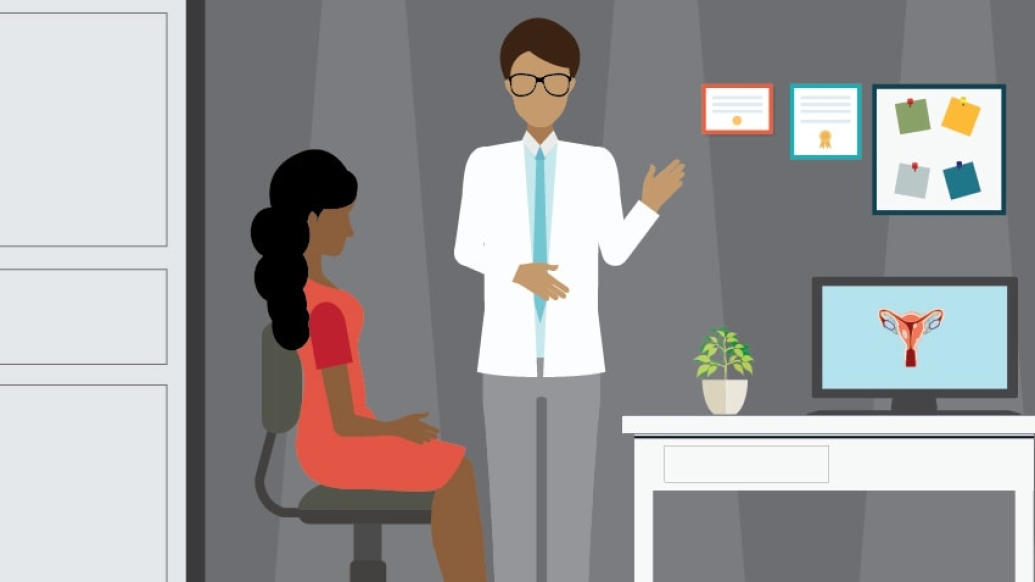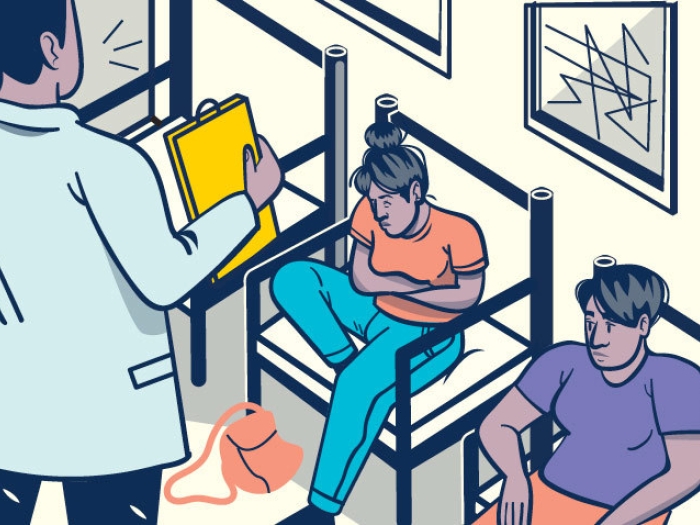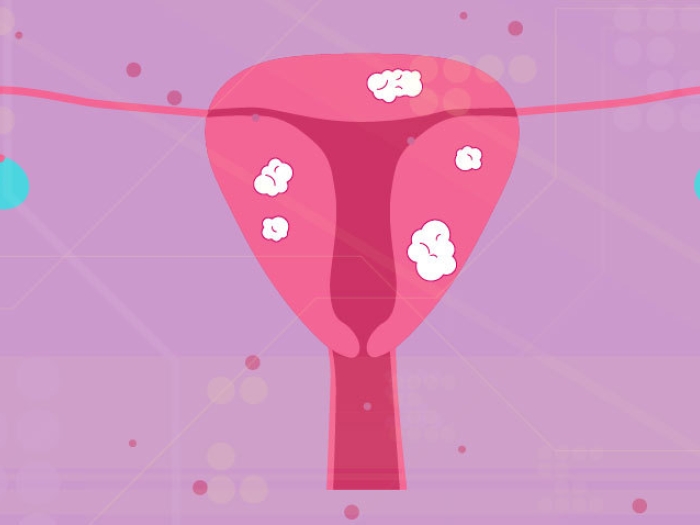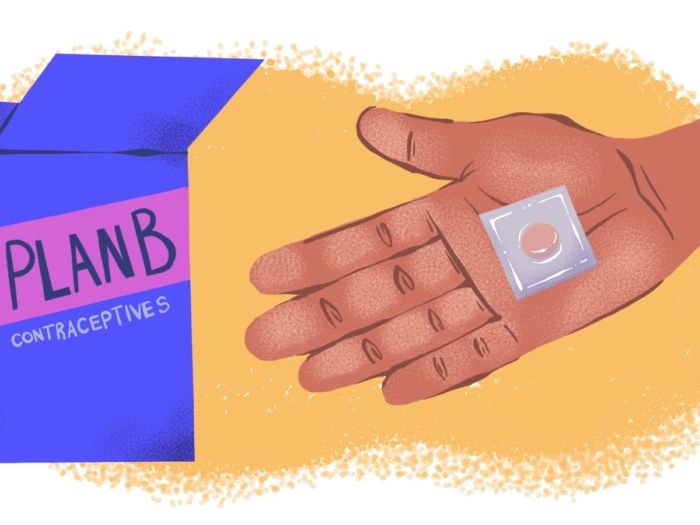Nearly two-thirds of women experience fibroids by age 50, but many may not be aware of nonsurgical treatment options. A U-M expert debates this issue at a national meeting.
7:00 AM
Author |

Uterine fibroids are the most common benign tumors in women of childbearing age and the second most common reason these women undergo surgery.
MORE FROM THE LAB: Subscribe to our weekly newsletter
But as research advances and new approaches to care are implemented, will surgery become less necessary for women looking to eliminate symptoms?
That's the question Erica Marsh, M.D., chief of the division of reproductive endocrinology and infertility at the Center for Reproductive Medicine at U-M's Von Voigtlander Women's Hospital, will debate during a keynote lecture at the annual The American College of Obstetricians and Gynecologists meeting this week.
Uterine fibroids cause no symptoms in nearly half of women who have them, but for others, they can cause major quality of life issues, and women may experience significant pain, bleeding and fertility problems. Treatment options range from watchful waiting to medications to major surgery to remove the uterus.
Marsh, who is U-M's lead researcher for a national project among several U.S. centers to compare treatment strategies and improve fibroid treatment, answers some questions about this topic.
How common are fibroids, and who is at greatest risk?
Marsh: Uterine fibroids are an incredibly prevalent disease, with 65 to 70 percent of all women having them by the age of 50. This disease is also associated with significant racial disparities. When we look at prevalence of the disease, close to 90 percent of African-American women will have fibroids by age 50.
Our No. 1 goal is to see prevention of fibroids. Until that happens, the next best thing is to ensure treatment options that prevent fibroids from becoming symptomatic.Erica Marsh, M.D.
Is surgery the only cure?
Marsh: Surgery is definitely not the only option for fibroids, though that is a common misconception. I think there are many women who either from their own experience or by secondary experience via social media, or friends and family, think a hysterectomy is the only treatment for fibroids. Depending on where a patient lives and who her health care provider is, many may hear that surgery is the only option. This is problematic because those who don't want to have surgery may disengage from the health care system, returning years later when options are more limited.
As of today, the only definitive way to ensure you will never have a fibroid recurrence is to have a hysterectomy, but women need to be aware of other options that are also effective in treating the condition.
For many patients, nonsurgical options are appropriate and sufficient. This may include oral medications, injectable medications, intrauterine devices and radiological procedures.
How do you help patients make the right decision about treatment?
Marsh: There are pros and cons of every option, but no intervention is risk-free. The magnitude of risk varies as do the benefits. We counsel patients as they decide what risks are acceptable and what benefits they're looking for.
SEE ALSO: Plotting the Downward Trend in Traditional Hysterectomy
The most important drivers of the treatment plan are whether the patient wants to carry a pregnancy in the future, and how comfortable she is with removing her uterus. Some women want to keep their uterus simply because it is theirs, and they see it as part of who they are and part of their identity. For women who are open to losing their uterus, the next question is if they are open to surgery.
Alternative therapies may include treatment with drugs or hormones through oral medications, injectable medications or intrauterine devices. Another option is a myomectomy, a procedure involving removal of only the fibroids instead of the uterus.
It's important that patients understand the risks and benefits of all treatments, so they are empowered to make an informed, regret-free decision.
What prevents women from getting treatment right away?
Marsh: This disease often gets delayed treatment because women are not aware they have symptoms. Some women think what they are experiencing is a normal part of aging, when in fact, their symptoms are synonymous with fibroids. We need to do a better job of educating our communities and patients about the signs and symptoms of fibroids and what's normal and what is not normal around menstrual cycles. Improved education around treatment options is also key. We need more people engaged in research around this topic. It is one of the most prevalent conditions women face, and we need to empower more people to ask questions and propose solutions.
What is the goal of your research?
Marsh: Right now, there's very little clinical trial data on fibroid outcomes that allow us to compare outcomes between patients who receive different therapies for fibroids. Understanding how quality of life, recurrence rates and fertility rates differ between treatments is critical information for women, their families and clinicians who are making decisions about fibroid care.
U-M is among several clinical centers across the country working to compare the effectiveness of different treatment strategies for women with uterine fibroids. This effort centers around building a national registry tracking patients, treatments and outcomes, and will help us answer key questions to better counsel our patients, including: What can I tell my patients about the risk of recurrence after one treatment versus another? The impact on fertility? The likelihood that her symptoms will return?
How are patients getting involved?
Marsh: An increasing number of stakeholders who are invested in better options and solutions for patients have systemic fibroids themselves. There are ever-increasing grass roots movements that are patient-driven. Women who suffer from fibroids are demanding better options and better care.
SEE ALSO: Empowering Local Doctors to Expand Women's Health Care in Ethiopia
Do you imagine a day when surgery is not needed for this condition?
Marsh: Our debate is intended to help guide discussion and explore this issue in more depth for attendees. In real life, however, treatment decisions are not either/or. It's about having a discussion with the patient to understand her priorities and educating her about all of the treatment options. We aim to empower the patient to make an informed decision about the best choice for her.
I think the goal is for fibroids to become obsolete some day. For those of us who treat patients, we hope to better understand these tumors and are doing research to understand how they develop. Our No. 1 goal is to see prevention of fibroids. Until that happens, the next best thing is to ensure treatment options that prevent fibroids from becoming symptomatic. And after that, we want to explore the most minimally invasive treatment options.
Patients have different priorities, and you have to meet them where they are and where their needs are—sometimes that's going to involve surgery. But we hope to someday see a time when this disease is no longer the leading cause of hysterectomy in the U.S.

Explore a variety of healthcare news & stories by visiting the Health Lab home page for more articles.

Department of Communication at Michigan Medicine
Want top health & research news weekly? Sign up for Health Lab’s newsletters today!





